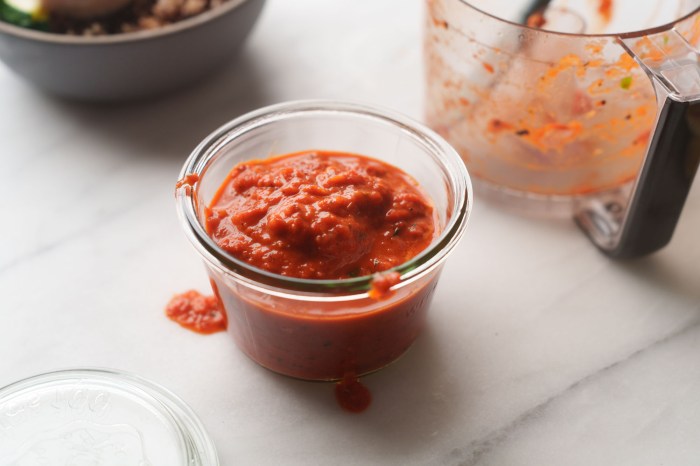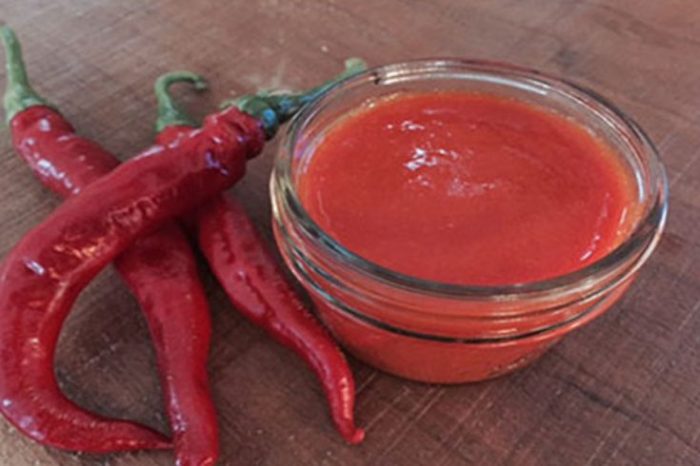Asian Hot Pepper Sauce Recipe A Flavorful Guide
Asian Hot Pepper Sauces: A Flavorful Journey: Asian Hot Pepper Sauce Recipe
Asian hot pepper sauce recipe – Asian hot pepper sauces represent a diverse tapestry of culinary traditions, each region boasting unique ingredients and flavor profiles. From the fiery sambal of Indonesia to the savory gochujang of Korea, these sauces add a complex dimension of heat and flavor to countless dishes. This exploration delves into the history, ingredients, regional variations, and culinary applications of these versatile condiments.
Introduction to Asian Hot Pepper Sauces, Asian hot pepper sauce recipe

Source: hungryhuy.com
The use of chili peppers in Asian cuisine dates back centuries, with their cultivation and incorporation varying significantly across different regions. Early trade routes facilitated the spread of chili peppers throughout Asia, leading to the development of diverse sauces reflecting local tastes and available ingredients. Popular examples include sriracha (Thailand), a fermented chili sauce with garlic and sugar; gochujang (Korea), a fermented chili paste with soybeans and glutinous rice; and sambal oelek (Indonesia), a simple chili paste made primarily from ground chilies.
Chili peppers hold significant cultural importance, symbolizing heat, vitality, and even good fortune in many Asian cultures, often playing a central role in celebrations and festivals.
Key Ingredients and Their Properties
A wide array of chili peppers contribute to the diverse heat levels and flavor profiles of Asian hot pepper sauces. The Scoville scale measures the pungency (heat) of chili peppers; varying from mild to extremely hot. Beyond chili peppers, other crucial ingredients provide balance and complexity. Vinegar adds acidity and brightness, while garlic and ginger contribute savory depth and aroma.
Sugar tempers the heat and adds sweetness, creating a harmonious flavor profile.
| Chili Pepper | Scoville Heat Units (SHU) | Flavor Profile | Common Use |
|---|---|---|---|
| Serrano | 10,000-23,000 SHU | Bright, slightly fruity | Sriracha, Sambal |
| Bird’s Eye Chili | 50,000-100,000 SHU | Fiery, intense | Sambal Oelek, Thai curries |
| Habanero | 100,000-350,000 SHU | Fruity, sweet, and extremely hot | Some variations of Sambal |
| Gochugaru (Korean Chili Flakes) | Variable, depending on type | Slightly sweet, smoky | Gochujang, Kimchi |
Recipe Variations Across Asia
The diverse culinary landscapes of Asia have resulted in a multitude of hot pepper sauce recipes. Each variation reflects the unique ingredients and flavor preferences of its region. For instance, Gochujang from Korea showcases a savory, fermented flavor profile, while Sambal Oelek from Indonesia delivers a fiery, straightforward chili punch.
- Gochujang (Korea): Gochugaru (Korean chili flakes), glutinous rice, soybeans, meju (fermented soybean paste), salt, and sometimes garlic and ginger.
- Sambal Oelek (Indonesia): Bird’s eye chilies, often with a touch of salt.
- Sriracha (Thailand): Bird’s eye chilies, garlic, sugar, vinegar, salt.
Making Your Own Asian Hot Pepper Sauce
Creating a versatile Asian hot pepper sauce at home allows for customization of heat and flavor. Start with a base of your chosen chili peppers, vinegar, garlic, and ginger. Adjust the proportions to achieve your desired level of spiciness. Remember to wear gloves when handling chilies to prevent skin irritation.
- Combine chilies, garlic, and ginger in a food processor and blend until finely chopped.
- Add vinegar and sugar; adjust quantities to taste.
- Simmer the mixture gently for 15-20 minutes, stirring occasionally, until slightly thickened.
- Allow to cool completely before storing.
Culinary Applications and Serving Suggestions

Source: oldworldgardenfarms.com
Asian hot pepper sauces enhance a wide array of dishes, adding both heat and depth of flavor. Their versatility extends beyond Asian cuisine, complementing various international dishes.
| Dish | Asian Hot Pepper Sauce Suggestion | Notes |
|---|---|---|
| Noodles | Sriracha, Sambal Oelek | Adds heat and umami |
| Stir-fries | Gochujang, Sweet Chili Sauce | Provides savory depth and sweetness |
| Dipping Sauce | Sambal Oelek, mixed with soy sauce and lime juice | Creates a vibrant dipping sauce for spring rolls or dumplings |
| Eggs | Any Asian hot pepper sauce | Adds a spicy kick to scrambled or fried eggs |
Preservation and Storage
Proper preservation ensures the longevity and safety of homemade Asian hot pepper sauces. Canning and freezing are effective methods. Homemade sauces generally have a shorter shelf life than commercially produced ones due to the absence of preservatives. Look for signs of spoilage such as mold growth, unusual color changes, or off-odors.
Visual Representation of Ingredients
The vibrant colors and textures of the ingredients are integral to the appeal of Asian hot pepper sauces. Bright red chilies, pearly white garlic cloves, and pale ginger root form the foundation. During cooking, the chilies soften and release their color, creating a rich, deep hue. A well-made sauce possesses a smooth, consistent texture, with a glossy sheen indicating proper cooking and consistency.
FAQ
Can I adjust the heat level in the recipe?
Absolutely! The amount of chili peppers used directly impacts the heat. Start with less and gradually add more to reach your desired level of spiciness.
Creating a vibrant Asian hot pepper sauce involves balancing heat and flavor. The sweetness of the peppers can be surprisingly well-balanced with other elements; for instance, consider the unexpected pairing with savory dishes, such as those using a delicious apple sauce recipe pork , where the tartness of the apples complements the spice. Ultimately, the best Asian hot pepper sauce recipe is one that you tailor to your own taste preferences.
How long will homemade Asian hot pepper sauce last?
Properly stored in a sterilized jar in the refrigerator, homemade Asian hot pepper sauce can last for several months. Look for signs of mold or spoilage before consuming.
What are some substitutes for ingredients if I can’t find them?
Substitutions depend on the specific ingredient. For example, if you can’t find a particular type of chili pepper, you can experiment with others, adjusting the amount to match the desired heat level. Similar substitutions can be made for other ingredients, such as vinegar types or types of sugar.





















